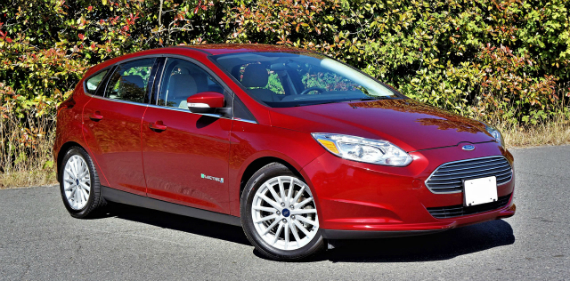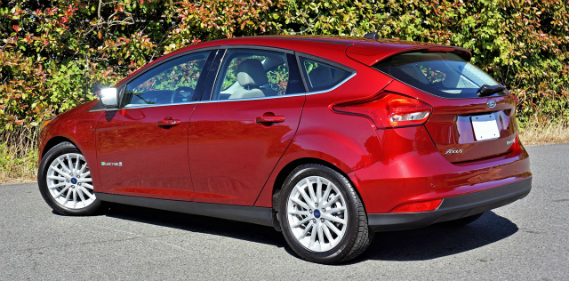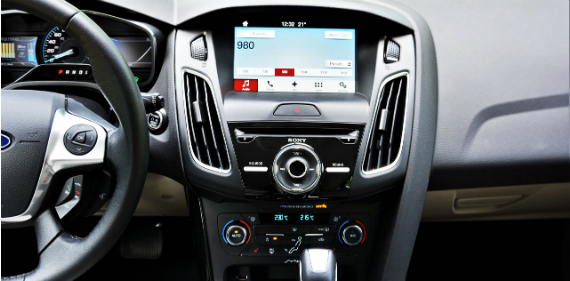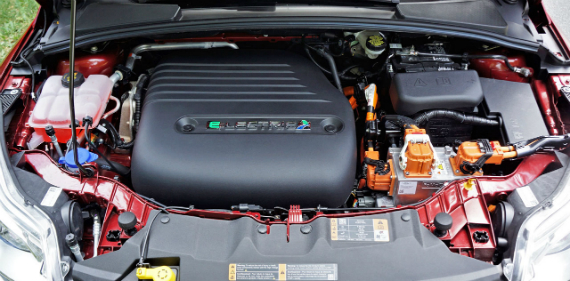2017 Ford Focus Electric

The EV to beat for value
Let’s be clear. Two things matter most with the majority of electric car buyers: range and price. If it can drive far enough on a single charge to be practical and doesn’t cost too much more than a conventionally powered equivalent then some semblance of sales success will follow.
Being that the latter situation hasn’t fully materialized I probably should’ve mentioned a third criteria to electric vehicle success, government support. Everywhere that EVs are relatively plentiful you’ll also find well-funded taxpayer programs, first to reduce the cost of initial purchase through rebate programs, and secondly to supply the necessary public charging stations to facilitate life with a plug-in vehicle.
The IRS tax credit ranges between $2,500 and $7,500, with the Focus EV qualifying for maximum money back. A number of states offer financial incentives too, so do your homework (or ask your Ford dealer) to find out. We can discuss how fair it is that many hardworking Americans who can’t afford a new car are stuck paying for those who have more, but that’s a philosophical and/or political question for another time. Rather, it’s probably better to talk about how you can get your hands on some of that “free” money by purchasing one of these electrics, because it might be a lot more within your reach than you may have previously thought.
Let’s start by doing some elementary math. The 2017 Focus Electric starts at $29,120 plus freight, fees and taxes, but Ford is currently (Dec 1, 2017) offering $13,000 of no-haggle lease incentives so you can have it for $16,120 before freight and taxes, or maybe less if you ask nicely or play as if your trade-in is worth more than you know it actually is. Even if you decide to pay cash you can be driving a Focus Electric for $21,620 after the federal rebate or possibly less if you live in a state that adds an incentive of its own, not to mention any discount that would certainly be available if you’re willing to buy a 2017 this time of year.

Factor in that you’ll be paying a fraction of what you’d otherwise ante up for fuel, or potentially nothing at all if you coordinate your daily outings so as to plug-in at the many aforementioned charging stations that have yet to start charging users money in most jurisdictions, and you should easily be able to add up exactly how much you’ll be saving by chopping 100 percent off your auto fuel budget.
Electric car maintenance is much lower too, especially under the hood where there’s so much less to go wrong, and while it’s difficult to put a price on using HOV lanes with only a driver in the car, to some people “time is money,” as Mr. Franklin once said.
But does the Ford Fusion Electric meet the other key EV objective? Does is supply enough range after a full charge to satisfy practical applications? After a week spent in the original 2013 Focus Electric back in the fall of 2012, I certainly didn’t think it was worth my tester’s rather steep $39,200 as-tested price, especially with 76 miles of best-scenario range in ideal conditions, a maximum of 55 being all that ever showed up on my tester’s gauge cluster. I never dared try to find its real-world limit, because it was too difficult to guess and I didn’t want to get stranded on a bridge somewhere.
That was then, this is now. Where the old 2013 Focus Electric was better left in the hands of adventurous souls not affected by range anxiety, today’s 2017 Focus Electric qualms any such worries thanks to 100 miles of EPA-estimated range. That’s still seven miles short of the Nissan Leaf, the world’s best-selling electric, and eons less capable than the new Chevy Bolt that can manage up to 238 miles per charge (believe me, I couldn’t drain the Bolt’s batteries no matter how hard I flogged it), but the Bolt begins at $37,495 before freight and fees, while the Leaf’s price range starts at $30,680 and rises to a lofty $38,360 when fully trimmed out, which makes the Focus Electric appear pretty thrifty even when paying an extra $395 for its fanciest paint job and another $1,0800 for leather upholstery.

But still, is the new Focus Electric livable? Not from an interior ergonomics and passenger/cargo practicality perspective, but with respect to real-world range? All I can say is it never posed any concerns throughout my test week, as long as I was willing to stop for a couple of hours at a time to top it up. The range indicator is a true pessimist. What I mean is, with my odometer at 2,397 miles and range indicator at 40 miles, I drove 17 miles to 2,414 miles and had a prospective range of 36 miles showing. Yes, only 4 miles had passed on the range indicator despite driving a true 17 miles across town. This is due to going easy on the throttle when taking off, applying my brakes more smoothly and longer while going downhill, and using other EV techniques to get the most out of a single charge.
On that note, Ford just added a new electronic braking coach designed to train drivers to decelerate more effectively, so as to recover more energy from the car’s regenerative braking system. Just follow the prompts and you’ll get farther from a single charge. The range indicator was never optimistic by the way, a good thing as I wouldn’t want to think I could drive farther than it would take me, but of course exactness would’ve been ideal.
The problem lies with factors a simple estimator can’t possibly surmise. There’s no way for the range indicator to factor in potential speeds, time on the highway eating up energy quickly, or aforementioned hills, which while beneficial on the way down aren’t your friend on the way up. It can’t prejudge your mood either, its ability to hold a charge much greater if you’re moseying along in a relaxed manner instead of darting through city traffic as if you’re Lucas Di Grassi charging through the streets of NYC, Hong Kong or Montreal on your way to winning the Formula E drivers’ title. In the real world, restraint pays off.
Still, the Focus EV is no slouch off the line, its fun factor surprising many in the sport compact tuner crowd during my test week. It’s agile through corners too, its underpinnings consisting of MacPherson struts and a stabilizer bar up front, plus a Control Blade independent suspension with a stabilizer bar in back, while electric power-assisted steering takes care of curves and torque-vectoring control aids handling. Along with good performance the Focus EV provides a nice comfortable ride, resulting in a good choice for everyday driving.

Unlike the even quicker subcompact Chevy noted earlier, this larger compact five-door hatch provides a much more refined place to go about your business, its interior featuring a soft-touch dash top, the same quality pliable synthetic for the front door uppers, and considerably more passenger room front to back. And while I like the larger display and more colorful Apple-like graphics in the Bolt’s infotainment system, it’s hard to fault the Focus Electric’s Sync 3 system either, it’s modernize graphics some of the nicest in the industry, its features complete and functions quick reacting.
Features in mind, Ford keeps things simple with one trim level and a couple of available options just noted a moment ago. This means every single 2017 Focus Electric gets a completely unique one-piece grille with chromed and piano black accents that you’ll either love for looking like an Aston Martin or loathe for the same reason (how hard would it be to graft on a Focus ST front clip?), plus standard auto on/off headlights with signature LEDs, dedicated DRLs, LED taillights, power-adjustable heated side mirrors with integrated turn signals, approach lighting and special blindspot mirrors, chrome beltline moldings, a rear rooftop spoiler, 17-inch Sparkle Silver-painted alloys, an SAE J1772 CCS charge port with a new illuminated LED state of charge indicator, and that’s only on the outside.
Remote start will prepare the Focus Electric before you get there via MyFord Mobile with remote cabin preconditioning, while proximity access with pushbutton ignition gets you inside and ready to go. Additional standard features include illuminated entry, ambient lighting, an electromechanical parking brake, a tilt and telescopic leather-wrapped multifunction steering wheel, Ford’s SmartGauge with EcoGuide instrument cluster, two driver configurable 4.2-inch color LCD multi-information displays within the same primary gauge cluster, a message center with a trip computer, variable intermittent wipers, cruise control, dual-zone auto climate control, Sync 3 infotainment with an 8.0-inch capacitive touchscreen featuring tap and swipe capability, enhanced voice recognition, navigation, a rearview camera, Apple CarPlay and Android Auto smartphone connectivity, Bluetooth, great sounding nine-speaker Sony audio, satellite radio, a full-floor center console with storage, cupholders and two chargeable USB ports, a leather-wrapped shift knob, illuminated vanity mirrors, heatable front seats, rear heat vents, a rear center armrest with storage, one-touch up/down powered windows front and back, a removable rear package tray, and 60/40 split-folding rear seatbacks.

On the safety front, the 2017 Focus Electric includes hill start assist, tire pressure monitoring, traction and stability control, ABS-enhanced four-wheel disc brakes, and all the usual airbags including one for the driver’s knees, but so far no advanced driver-assistance systems like forward collision warning, autonomous emergency braking, blindspot alert, lane departure warning, self steering capability, self parking, dynamic cruise control, auto high beams, etcetera.
I doubt those looking for a relatively inexpensive EV will care all that much about such advanced safety systems, which of course would push the Focus Electric’s price much higher if standard or available. This car is more about getting environmentally conscious consumers on the road to a brighter, cleaner future.
To that end the power unit has been upgraded for 2017, its lithium-ion battery now more “energy dense” than the outgoing model, says Ford. Now it can manage 33.5 kWh instead of 23.0 kWh, which makes it more capable than the outgoing 2017 Leaf’s 30-kWh battery and Kia Soul’s 27-kWh power unit. Altogether, the new Focus Electric makes 143 horsepower and 184 lb-ft of torque from a 107 kW electric motor, while using a single-speed direct-drive transmission to power the front wheels.
Of note, its new MGEe rating is 118 in the city and 96 on the highway, but these numbers are really difficult to make sense of so just use them for comparison tools with other EVs.
Also important, the Focus Electric will recharge faster due to a new standard 50kW-capable DC fast charge port, the result being an 80-percent charge in less than half an hour. This will eventually make it easier to travel long distances, although you’ll be hard pressed to find a publicly available DC fast charging port now. Alternatively, you’ll need five and a half hours to charge from zero to full via a 240-volt charge station, or 30 hours from a regular household outlet. That last point is the challenge, as most of us need to charge daily. Therefore, if you’re not prepared to pay extra for a 240-volt home charging system (and check with your local utility company for rebate money to help with this), you might want to look for an EV that’ll fill up faster.

On the subject of filling things up, the Focus Electric’s Achilles heel is its cargo compartment, its big battery robbing much of the car’s otherwise practical space. When first opening the rear hatch you’ll see the load floor is unusually slanted rearward, its dual function more of a lid for a large 1.5 cubic-foot lower compartment in this position. Lift it up, however, and you can lock it into a much more useful flat position, allowing easy luggage loading and ample space for most peoples’ needs. Still, at just over 14.2 cubic feet behind the rear seatbacks it’s nowhere near as voluminous as the regular Focus Hatchback’s 23.2 cubic-foot capacity, and likewise its 33.2 cubic-foot max load carrying capability is far less than the conventionally powered hatch’s 43.9 cubic-foot max capacity. It’s just one of those compromises EV buyers need to accept, but truth be told not all electrics force you to give up so much space.
Most require you to pay more money, however, so the Focus Electric remains the EV to beat when it comes to great value from a practical, high quality, fun to drive package.
Story credits: Trevor Hofmann, American Auto Press Photo credits: Karen Tuggay, American Auto Press Copyright: American Auto Press
